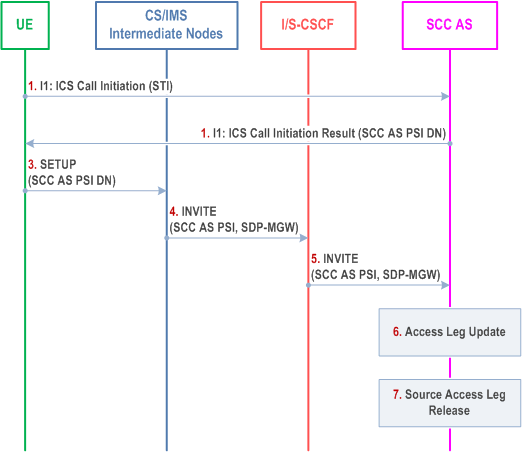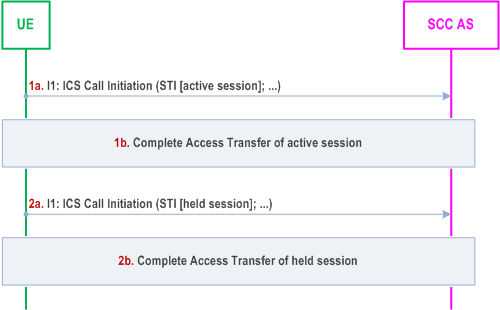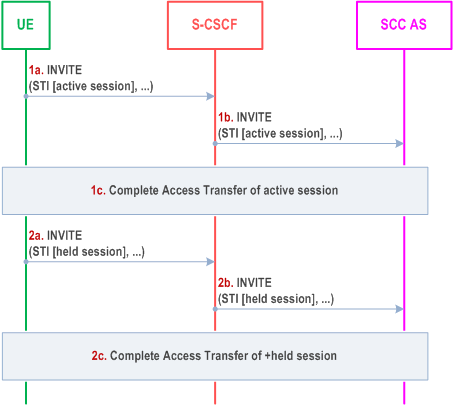Content for TS 23.237 Word version: 18.0.0
0…
4…
5…
5.4…
6…
6.2…
6.2.2…
6.3…
6.3.2…
6.3.2.1.3…
6.3.2.1.7…
6.3.2.1.9…
6.3.2.2…
6.3.2.3…
6.3.2.3.6…
6.3.3…
6.4…
6a…
6a.3…
6a.4…
6a.4.3…
6a.4.5…
6a.4.7…
6a.4a…
6a.5…
6a.6…
6a.7…
6a.8…
6a.9…
6a.10…
6a.11…
6c…
7…
A…
B…
C…
6.3.2.3.6 PS - PS in conjunction with PS - CS Access Transfer: Explicit Communication Transfer - Using Gm reference point
6.3.2.3.7 PS - PS in conjunction with PS - CS Access Transfer: Conferencing - Using Gm reference point
6.3.2.3.8 PS - PS in conjunction with PS - CS Access Transfer: PS to CS - using I1 reference point
6.3.2.3.9 PS - PS in conjunction with PS - CS Access Transfer: CS to PS - using I1 reference point
6.3.2.3.10 PS - PS in conjunction with PS - CS Access Transfer: PS to CS for Active/Held sessions - using I1 reference point
6.3.2.3.11 PS - PS in conjunction with PS - CS Access Transfer: CS to PS for Active/Held sessions - using I1 reference point
...
...
6.3.2.3.6 PS - PS in conjunction with PS - CS Access Transfer: Explicit Communication Transfer - Using Gm reference point p. 91
Prior to consultative transfer, the transferor UE may have one session with the transferee UE and one session with the transfer target UE. If the transferor UE performs Access Transfer in this case, the information flow for PS-PS in conjunction with PS-CS Access Transfer: Explicit Communication Transfer is the same as the information flow in clause 6.3.2.3.5 PS-PS in conjunction with PS-CS Access Transfer: Active/held sessions.
For all other cases in ECT service, there is only one session at the UE. Depending on the direction of the Access transfer, the following information flows apply:
- the information flow in clause 6.3.2.3.3 for PS-PS in conjunction with PS-CS Access Transfer: PS to CS; or,
- the information flow in clause 6.3.2.3.4 for PS-PS in conjunction with PS-CS Access Transfer: CS to PS.
6.3.2.3.7 PS - PS in conjunction with PS - CS Access Transfer: Conferencing - Using Gm reference point p. 91
The information flows for PS-PS in conjunction with PS-CS Access Transfer: Conferencing in PS to CS and CS to PS directions, are the same as the information flows in clause 6.3.2.3.3 PS-PS in conjunction with PS-CS Access Transfer: PS to CS for UEs with ICS capabilities, and clause 6.3.2.3.4 PS-PS in conjunction with PS-CS Access Transfer: CS to PS for UEs with ICS capabilities respectively.
The flow requires that the user is in an active or inactive IMS originating and/or terminating sessions with the Conferencing service; the Gm reference point of ICS is used for control of IMS sessions that use CS media.
6.3.2.3.8 PS - PS in conjunction with PS - CS Access Transfer: PS to CS - using I1 reference point |R9| p. 91
Figure 6.3.2.3.8-1 PS-CS in conjunction with PS-CS Access Transfer: PS to CS access - using I1 reference point, provides an information flow for Access Transfer of real time media flow(s) of an IMS session in PS to CS direction.
The flow requires that the user is in an active or inactive IMS originating or terminating session; the I1 reference point of ICS is used for control of IMS sessions that use CS media; and a unique STI is associated with each session.

Step 1.
When the UE determines a need for Access Transfer, the UE initiates registration with IMS via the new PS access (if not already registered) as specified in clause 6.1. It subsequently initiates the "Originations to a SIP URI" procedure as specified in clause 7.3.2.2.2.1 of TS 23.292 by sending an I1, ICS Call Initiation including the STI to establish the Access Leg via the PS access.
Step 2.
The SCC AS identifies the session to be transferred using the STI, and continues the "Originations to a SIP URI" procedure for completion of the setup of CS media for the Access Leg by allocating a SCC AS PSI DN and sending it in an I1, ICS Call Initiation Result; see TS 23.292 for SCC AS PSI DN.
Step 3.
The UE continues the "Originations to a SIP URI" procedure by sending a Setup message including the SCC AS PSI DN to establish the CS media for the Access Leg.
Step 4.
The "Originations to a SIP URI" procedure is used at the CS and IMS intermediate nodes, resulting in routeing of an INVITE with the SCC AS PSI to the I/S-CSCF.
Step 5.
The I/S-CSCF forwards the INVITE with the SCC AS PSI and SDP of the MGW as part of the "Originations with CS media using the Gm reference point" procedure.
Step 6.
The SCC AS uses the SCC AS PSI to correlate the CS bearer control signalling request received via the CS access with the Access Transfer request previously received via the PS access.
The SCC AS completes the establishment of the Access Leg by combining the description of the media established via the CS access with the description of the media flow(s) established via the PS access for the signalling associated with the Access Leg.
The SCC AS performs the Access Transfer by updating the Remote Leg with the media description and other information of the newly established Access Leg using the Remote Leg Update procedure as specified in clause 6.3.5.
Step 7.
The Source Access Leg (which is the Access Leg previously established over PS access) is released as specified in clause 6.3.6.
6.3.2.3.9 PS - PS in conjunction with PS - CS Access Transfer: CS to PS - using I1 reference point |R9| p. 93
The information flow for Access Transfer of real time media of an IMS session in CS to PS direction when the I1 reference point is used for service control of sessions that use CS media, is the same as the information flow PS-CS Access Transfer: CS to PS access, as specified in clause 6.3.2.1.2.
The flow requires that the user is in an active or inactive IMS originating or terminating session; the I1 reference point of ICS is used for control of IMS sessions that use CS media; and a unique STI is associated with each session.
6.3.2.3.10 PS - PS in conjunction with PS - CS Access Transfer: PS to CS for Active/Held sessions - using I1 reference point |R9| p. 93
Figure 6.3.2.3.10-1 PS - PS in conjunction with PS - CS Access Transfer: PS to CS for Active/Held sessions - using I1 reference point, provides an information flow for Access Transfer of real time media of one active and one or more held sessions from PS to CS when the I1 reference point is used for service control of sessions that use CS media.
The flow requires that the user is active in IMS originating and/or terminating sessions; the I1 reference point of ICS is used for control of IMS sessions that use CS media; and a unique STI is associated with each session.

Step 1a.
Steps 2a and 2b are repeated for the remaining held sessions.
When the UE determines a need for Access Transfer, the UE initiates the Access Transfer of the active session as specified in clause 6.3.2.3.8 PS - PS in conjunction with PS - CS Access Transfer: PS to CS - using I1 reference point The STI of the active session is used by SCC AS to identify the active session.
Step 1b.
The UE and the SCC AS complete the Access Transfer of the active session.
Step 2a.
The UE initiates the Access Transfer of the first held session using the same procedures as identified in steps 1a and 1b with a difference that the CS media is not established for the held session; the media path established upon transfer of the currently active session is reused for the held session when it is resumed. The STI of the held session is used by SCC AS to identify the held session.
Step 2b.
The UE and the SCC AS complete the Access Transfer of the held session.
6.3.2.3.11 PS - PS in conjunction with PS - CS Access Transfer: CS to PS for Active/Held sessions - using I1 reference point |R9| p. 94
Figure 6.3.2.3.11-1 PS - PS in conjunction with PS - CS Access Transfer: CS to PS for Active/Held sessions - using I1 reference point, provides an information flow for Access Transfer of real time media of one active and one or more held sessions from CS to PS when the I1 reference point is used for service control of sessions that use CS media.
The flow requires that the user is active in IMS originating and/or terminating sessions; the I1 reference point of ICS is used for control of IMS sessions that use CS media; and a unique STI is associated with each session.

Step 1a, 1b.
Steps 2a, 2b and 2c are repeated for the remaining held sessions.
When the UE determines a need for Access Transfer, the UE initiates the Access Transfer of the active session as specified in clause 6.3.2.3.9 PS - PS in conjunction with PS - CS Access Transfer: CS to PS - using I1 reference point. The STI of the active session is used by SCC AS to identify the active session.
Step 1c.
The UE and the SCC AS complete the Access Transfer of the active session.
Step 2a, 2b.
The UE initiates the Access Transfer of the first held session using the same procedures as identified in steps 1a, 1b and 1c. The STI of the held session is used by SCC AS to identify the held session.
Step 2c.
The UE and the SCC AS complete the Access Transfer of the held session.